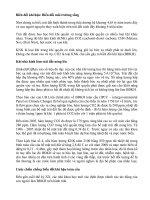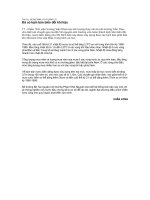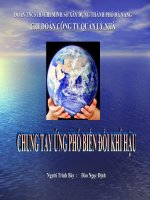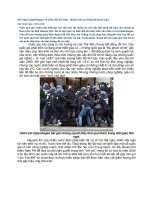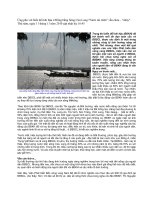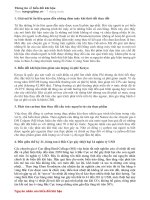Biến đổi khí hậu: Hiện tượng_nguyên nhân_khắc phục
Bạn đang xem bản rút gọn của tài liệu. Xem và tải ngay bản đầy đủ của tài liệu tại đây (186.27 KB, 6 trang )
Question 1: Weather and Climate???
Weather is the fluctuating state of the atmosphere around us, characterised by the temperature,
wind, precipitation, clouds and other weather elements. Weather is the condition of the
atmosphere at a particular place over a short period of time
“Climate” refers to the average weather in terms of the mean and its variability over a certain
time-span and a certain area. climate refers to the weather pattern of a place over a long period,
long enough to yield meaningful averages.
Question 2:
The climate system is an interactive system consisting of five major components:
•
The atmosphere,
•
The hydrosphere,
•
The cryosphere,
•
The land surface and the biosphere,
•
Forced or influenced by various external forcing mechanisms
Question 3:
•
The four layers of the atmosphere, in order from lowest to highest elevation, are:
–
the troposphere,
–
the stratosphere,
–
the mesosphere,
–
the thermosphere
Question 4: Greenhouse Gase.
Greenhouse Gases: carbon dioxide (CO2), methane (CH4), nitrous oxide (N2O) and ozone (O3),
which do absorb and emit infrared radiation.
Carbon dioxide enters the atmosphere through burning fossil fuels (coal, natural gas, and
oil), solid waste, trees and wood products, and also as a result of certain chemical
reactions (e.g., manufacture of cement).
Carbon dioxide is removed from the atmosphere (or "sequestered") when it is absorbed
by plants as part of the biological carbon cycle.
Question 6: Distinguish between Adaptation and Mitigation of Climate Change.
•
Adaptation: In human systems, the process of adjustment to actual (thực tế) or expected
climate and its effects, in order to moderate (vừa phải) harm or exploit(Khai thác)
beneficial opportunities. In natural systems, the process of adjustment to actual climate
and its effects; human intervention may facilitate adjustment to expected climate.
•
Mitigation
(of
climate
change)
Climate mitigation is any action taken to permanently eliminate or reduce the long-term risk and
hazards of climate change to human life, property. The term mitigation refers to efforts to cut or
prevent the emission of greenhouse gases.
It differs from climate change Adaptation and Mitigation may require us to use new
technologies, clean energy sources, change people's behaviour, or make older technology more
energy efficient.
Question 7: What is El Nino?
The term El Nino refers to the large-scale ocean-atmosphere climate interaction linked to a
periodic (chu ky) warming in sea surface temperatures across the central and east-central
Equatorial Pacific.
Happens every 2-7 years
Duration: normally 11 months
Effect of El Nino to Vietnam:
-
Typhoon: decrease about 27%
-
Tempareture: increase
-
Precipitation: decreas
-
Sea level: decrease
-
Salty level: increase
-
Flow of revier: decrease about 20%
Question 8: What is La Nina?
La Nina episodes (giai đoạn) represent periods of below-average sea surface temperatures across
the east-central Equatorial Pacific.
Duration: normally 14 months
Effect of El Nino to Vietnam:
-
Typhoon: increase
-
Tempareture: decrease
-
Precipitation: increas
-
Sea level: increase
-
Salty level: decrease
-
Flow of revier: increase
Question 9: What is Climate Extreme? Situation/phenomena(hiện tượng)?
•
•
•
Extreme weather includes unexpected, unusual, unpredictable severe or unseasonal
weather
The extreme weather depending on the longitude, latitude, topography and
atmospheric conditions.
Extreme weather may cause damage to people, property and serious social unrest
- Phenomena: Flood, sea-level rise, temperature increase, salinization, drought, storm more and more,…
Question 10: Các sinh vật ngoại lai di cư khi BĐKH ảnh hưởng ntn đối với hệ sinh thái?
TL: Làm phong phú hst,
BL: Sự cân bằng trong hệ sinh thái bị thay đổi do sự phát triển quá nhanh của sinh vật trong môi
trường mới.
Question 11: Tại sao Việt Nam là nước dễ bị tổn thương do BĐKH?
- Vị trí địa lý:
+ Đường bờ biền dài 3260km, Có 3 mặt giáp biển.( Viet Nam has the coastline of 3,260
kilometers)
+ Địa hình chủ yếu đồi núi. ( Terrain are primaly mountains and hills)
- Khí hậu (climate): Nhiệt đới gió mùa (Vietnam in the northern regions have a humid
subtropical climate)
- Developing Counttry: Bad condition economic, Bad condition education. . it isn’t enough
capable of finance and technology to apply solution in the climate change mitigation. The
knowledge of climate change in Vietnam have still limited.
Question 12: Cause of Climate Change.
•
Earth's temperature depends on the balance between energy entering and leavingthe
planet’s system.
•
The cause changes in Earth’s energy balance:
Variations in the sun's energy reaching Earth
Changes in the reflectivity of Earth’s atmosphere and surface
Changes in the greenhouse effect, which affects the amount of heat retained by Earth’s
atmosphere.
Two main cause: Natural processes and human activities.
•
The burning of fossil fuels, The conversion of land, Green house gas emissions from
activities industry. Vietnam is a developing country, so the production and
consumption of energy increase, especially in industry, transportation, urbanization
and increasing GHG emission. … (human).
•
Volcanic activity, The Earth's orbit around the Sun.. (Nature)
Question 13: Làm thế nào để thích ứng với BĐKH?
- Nâng cao cơ sở hạ tầng.
+ Đắp đê
+ Trồng rừng ngập mặn
- Dự báo trước để ứng phó theo các kịch bản BĐKH. Predict to adapt and mitigate following CC
Senario.
-Nghiên cứu các giống mới. Research many new breeds
Question 14: What is the CC senario?
- A climate change scenario is a plausible description of future climate, based on a set of
climatic relations, being developed to be used in studies of the consequence of climate
change induced by anthropogenic activities and often used as inputs for impact
assessments.
(Kịch bản BĐKH là những mô tả đáng tin về khí hậu trong tương lai dựa trên mối liên hệ chặt
chẽ của diễn biến tự nhiên,trong những nghiên cứu về hậu quả của BĐKH bị tác động bởi những
hoạt động của con người và được sử dụng trong việc đánh giá tác động.)
- Producing Senario: Climate, environment, Sea-level rise, land-use and Land Cover,
Socioeconomic.
Question 15: How many type of Climate change Senario are there?
- There are four types of Senario: A1, A2, B1, B2.
+ low emission scenario (B1)
+ medium emission scenario (B2)
+ high emission scenario (A2), A1
Question 16: Primary energy (PE) and Secondary energy?
•
Primary energy (PE) is an energy form found in nature . It is energy contained in raw
fuels, and other forms of energy received as input to a system. Primary energy can
be nonrenewable or renewable
•
Secondary energy should be used to designate all sources of energy that results from
transformation of primary sources
Question 17: What is fossil fuel?
•
A hydrocarbon deposit, such as petroleum, coal, or natural gas, derived fromthe accumul
ated remains of ancient plants and animals and used as fuel.
Question 18: Renewable energy
Renewable energy is defined as energy that is collected from resources which are naturally replenished
on a human timescale: Solar energy, wind energy, hydropower, Bio-energy, geothermal,…
Question 19: What is climate change???
Climate change is a long-term shift in weather conditions identified by changes in
temperature, precipitation, winds, and other indicators.
Question 20: Impact Of Climate Change On Biology
Question 21: Impact of climate change to water resources.
Ocean Acidity: Higher acidity affects the balance of minerals in the water.
Less snowpack.
Melting glaciers.
The rivers: Less snowpack and earlier snowmelt will reduce the amount of water flowing into the rivers.
(lượng băng tan chay sẽ làm giảm lượng nước chảy vào sông)
Hurricanes and other tropical storms: higher temperatures and increased evaporation, climate change
causes other types of storms to get stronger
Water Quality: Freshwater resources along the coasts face risks from sea level rise. As the sea rises,
saltwater moves into freshwater areas. And Drought can cause coastal water resources to become more
saline as freshwater supplies from rivers are reduced.
Question 22: the impacts of climate change on human health.
Exposure to extreme heat can lead to
Heat stroke; Dehydration; Cardiovascular; Respiratory; Cerebrovascular disease.
Air Quality Impacts: respiratory problems; lung diseases;…
Vectorborne Diseases: Lyme disease; West Nile Virus
People can become ill if exposed to contaminated drinking or recreational water.
Affect food safety and nutrition.
Question 23: the impact of climate change to land resource and forestry.
Question 24: the impact of climate change on agriculture.
Soil processes: influenced by changes in soil water balance
Crops
Grasslands and livestock: Increase in disease transmission by faster growth rates of pathogens in the
environment; be exposed to higher incidences of heat stress, thus influencing productivity.
Weeds, pests and diseases: evolve rapidly to overcome control measures,
Question 25: Vulnerability
Vulnerability can be seen the loss, degradation of the system, the level of tolerance, recover, its response
to the effects from the outside (hazards and human activities)

